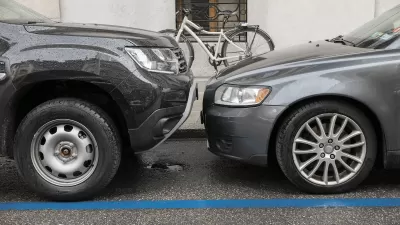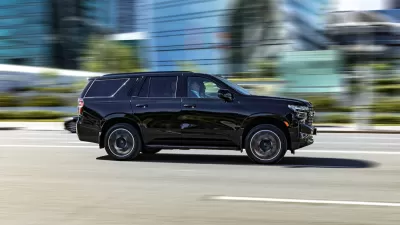A new study shows that modern safety features are more important than size and weight once vehicles weigh over 4,000 pounds.

The “bigger is safer” argument for large trucks and SUVs has reached a plateau, according to an analysis from the Insurance Institute for Highway Safety, which reveals that vehicles over 4,000 pounds don’t offer any significant safety benefits over lighter vehicles. For context, the average American car weighs 4,100 pounds, notes Kea Wilson in Streetsblog USA.
Although vehicle size and weight did, for a while, make a difference for safety, Wilson explains, “advances in other vehicle safety strategies like better front-end design and automatic emergency braking have increased the "crash compatibility" of average-sized vehicles, making the occupants of those cars more likely to survive being hit by the driver of a monster truck — though not necessarily sparing the lives of people outside cars when those drivers strike them.”
Meanwhile, safety continues to decrease for pedestrians and other people outside of the vehicles as vehicles get larger. Taller vehicles are more likely to strike people in the head or vital organs, while large cars and front ends can also obscure drivers’ visibility and perception of speed.
While Wilson acknowledges that “ regulators under President Trump are unlikely to mandate new safety updates to protect vulnerable road users,” many automakers are already voluntarily implementing changes, but pedestrian safety doesn’t always rank at the top of the upgrades list.
FULL STORY: Study: You’re Not That Much Safer In a 4,000+ Pound Car

Alabama: Trump Terminates Settlements for Black Communities Harmed By Raw Sewage
Trump deemed the landmark civil rights agreement “illegal DEI and environmental justice policy.”

Planetizen Federal Action Tracker
A weekly monitor of how Trump’s orders and actions are impacting planners and planning in America.

Why Should We Subsidize Public Transportation?
Many public transit agencies face financial stress due to rising costs, declining fare revenue, and declining subsidies. Transit advocates must provide a strong business case for increasing public transit funding.

Understanding Road Diets
An explainer from Momentum highlights the advantages of reducing vehicle lanes in favor of more bike, transit, and pedestrian infrastructure.

New California Law Regulates Warehouse Pollution
A new law tightens building and emissions regulations for large distribution warehouses to mitigate air pollution and traffic in surrounding communities.

Phoenix Announces Opening Date for Light Rail Extension
The South Central extension will connect South Phoenix to downtown and other major hubs starting on June 7.
Urban Design for Planners 1: Software Tools
This six-course series explores essential urban design concepts using open source software and equips planners with the tools they need to participate fully in the urban design process.
Planning for Universal Design
Learn the tools for implementing Universal Design in planning regulations.
Caltrans
Smith Gee Studio
Institute for Housing and Urban Development Studies (IHS)
City of Grandview
Harvard GSD Executive Education
Toledo-Lucas County Plan Commissions
Salt Lake City
NYU Wagner Graduate School of Public Service





























